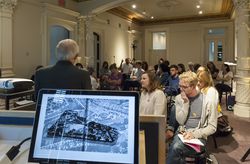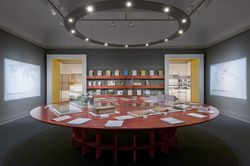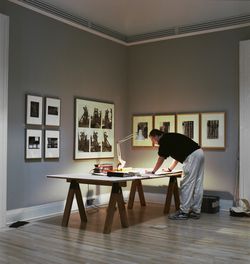Starting From... Windows
A window can be a void, an aperture, or a glass surface. Existing at the boundary between interior and exterior, windows admit light and air and frame views. The idea of the window, combined with advances in glass as a building material, became central to architectural experimentation during the modern period. This selection from the CCA collection presents a range of(...)
Hall cases
17 June 2010 to 27 September 2010
Starting From... Windows
Actions:
Description:
A window can be a void, an aperture, or a glass surface. Existing at the boundary between interior and exterior, windows admit light and air and frame views. The idea of the window, combined with advances in glass as a building material, became central to architectural experimentation during the modern period. This selection from the CCA collection presents a range of(...)
Hall cases
The CCA presents Toolkit for Today 2014, a summer seminar held as part of the TD Bank Group-CCA Collection Research Grants program. This year the seminar aims to address questions related to contemporary architecture, showing how projects enrich and diverge from each other and how their differences are born of unusual perspectives and new ways of articulating(...)
23 June 2014 to 28 June 2014
Toolkit for Today: Materials and Atmospheres
Actions:
Description:
The CCA presents Toolkit for Today 2014, a summer seminar held as part of the TD Bank Group-CCA Collection Research Grants program. This year the seminar aims to address questions related to contemporary architecture, showing how projects enrich and diverge from each other and how their differences are born of unusual perspectives and new ways of articulating(...)
Photographers Clara Gutsche and David Miller offer their vision of the industrial landscape and architecture surrounding the urban historical site of Lachine Canal in Montréal. The Canal, which is over one hundred years old, suffered a long period of neglect after having played a key role in the development of Canadian industry. Fifteen years after the waterway closed,(...)
Octagonal gallery
15 July 1992 to 22 November 1992
An Industrial Landscape Observed: The Lachine Canal
Actions:
Description:
Photographers Clara Gutsche and David Miller offer their vision of the industrial landscape and architecture surrounding the urban historical site of Lachine Canal in Montréal. The Canal, which is over one hundred years old, suffered a long period of neglect after having played a key role in the development of Canadian industry. Fifteen years after the waterway closed,(...)
Octagonal gallery
Parables and Other Allegories: The Work of Melvin Charney 1975–1990 comprises approximately 100 drawings, including many large-scale, sketches, photographs, and three large constructions. By assembling works from various public and private collections, including the CCA, the exhibition permits a comprehensive analysis of Charney’s artistic process to reveal the dialogue(...)
Main galleries
9 October 1991 to 12 January 1992
Parables and Other Allegories: The Work of Melvin Charney, 1975-1990
Actions:
Description:
Parables and Other Allegories: The Work of Melvin Charney 1975–1990 comprises approximately 100 drawings, including many large-scale, sketches, photographs, and three large constructions. By assembling works from various public and private collections, including the CCA, the exhibition permits a comprehensive analysis of Charney’s artistic process to reveal the dialogue(...)
Main galleries
As Building Director of Baden in southwest Germany, Friedrich Weinbrenner (1766–1826) had the unique opportunity to create in Karlsruhe—the capital and his native city—one of the most homogeneous architectural ensembles ever achieved by a single architect. The exhibition focuses on the impact of scientific and administrative reform on the urban and agricultural(...)
Main galleries
31 January 1990 to 18 March 1990
Friedrich Weinbrenner, Architect of Karlsruhe
Actions:
Description:
As Building Director of Baden in southwest Germany, Friedrich Weinbrenner (1766–1826) had the unique opportunity to create in Karlsruhe—the capital and his native city—one of the most homogeneous architectural ensembles ever achieved by a single architect. The exhibition focuses on the impact of scientific and administrative reform on the urban and agricultural(...)
Main galleries
Inter / Faces
How can architecture respond to a specific urban context? How can the various typologies and cultural needs of diverse inhabitants influence design? How to capture the character of a city through its buildings? Portuguese architect Álvaro Siza’s social housing projects Bonjour Tristesse and Punt en Komma, designed for immigrant communities in Berlin and The Hague(...)
29 November 2015, 2:30pm - 4:30pm
Inter / Faces
Actions:
Description:
How can architecture respond to a specific urban context? How can the various typologies and cultural needs of diverse inhabitants influence design? How to capture the character of a city through its buildings? Portuguese architect Álvaro Siza’s social housing projects Bonjour Tristesse and Punt en Komma, designed for immigrant communities in Berlin and The Hague(...)
Learning from... Brussels
Rotor members Michael Ghyoot and Maarten Gielen investigate the processes and practices of material management in Brussels and its suburbs. The concept of waste played a key role in their research and was informed by hundreds of visits to businesses, work sites, and recycling plants. The examination of discarded, unfinished products or those considered of inferior quality(...)
Paul Desmarais Theatre
19 April 2012 , 7pm
Learning from... Brussels
Actions:
Description:
Rotor members Michael Ghyoot and Maarten Gielen investigate the processes and practices of material management in Brussels and its suburbs. The concept of waste played a key role in their research and was informed by hundreds of visits to businesses, work sites, and recycling plants. The examination of discarded, unfinished products or those considered of inferior quality(...)
Paul Desmarais Theatre
The beginning of the 1950s was a moment of global upheaval. From India to Morocco, from Guatemala to Indochina, the process of decolonization gained momentum and the Cold War began. Architects working or acting as experts in the non-Western areas of the globe could no longer plan as if sites were terrains vague and people were mute subjects. The end of colonial(...)
Main galleries Keyword(s):
Casablanca, Chandigarh, Le Corbusier, Jeanneret, Morocco, Punjab, India, Morocco, modernism, Africa, Takashi Homma, Yto Barrada
26 November 2013 to 20 April 2014
How architects, experts, politicians, international agencies and citizens negotiate modern planning: Casablanca Chandigarh
Actions:
Description:
The beginning of the 1950s was a moment of global upheaval. From India to Morocco, from Guatemala to Indochina, the process of decolonization gained momentum and the Cold War began. Architects working or acting as experts in the non-Western areas of the globe could no longer plan as if sites were terrains vague and people were mute subjects. The end of colonial(...)
Main galleries Keyword(s):
Casablanca, Chandigarh, Le Corbusier, Jeanneret, Morocco, Punjab, India, Morocco, modernism, Africa, Takashi Homma, Yto Barrada
Architecture and Its Image examines the complex relationships between drawings, photographs, prints, and other architectural representations and the buildings, landscapes, and cities they represent. The exhibition assembles images dating from the early sixteenth century to the late twentieth century from Tokyo and Rome to Mississauga and Montreal and includes maps, books,(...)
7 May 1989 to 7 August 1989
Architecture and Its Image
Actions:
Description:
Architecture and Its Image examines the complex relationships between drawings, photographs, prints, and other architectural representations and the buildings, landscapes, and cities they represent. The exhibition assembles images dating from the early sixteenth century to the late twentieth century from Tokyo and Rome to Mississauga and Montreal and includes maps, books,(...)
The exhibition addresses a central and timely aspect of the work of Carlo Scarpa: its distinctive approach to contending with the layers of history that mark the fabric of a city and a building. In addressing Scarpa’s ability to weave new work into, and often out of, the disparate fragments of the old, Carlo Scarpa, Architect: Intervening with History begins to unravel(...)
Main galleries
26 May 1999 to 31 October 1999
Carlo Scarpa, Architect: Intervening with History
Actions:
Description:
The exhibition addresses a central and timely aspect of the work of Carlo Scarpa: its distinctive approach to contending with the layers of history that mark the fabric of a city and a building. In addressing Scarpa’s ability to weave new work into, and often out of, the disparate fragments of the old, Carlo Scarpa, Architect: Intervening with History begins to unravel(...)
Main galleries









